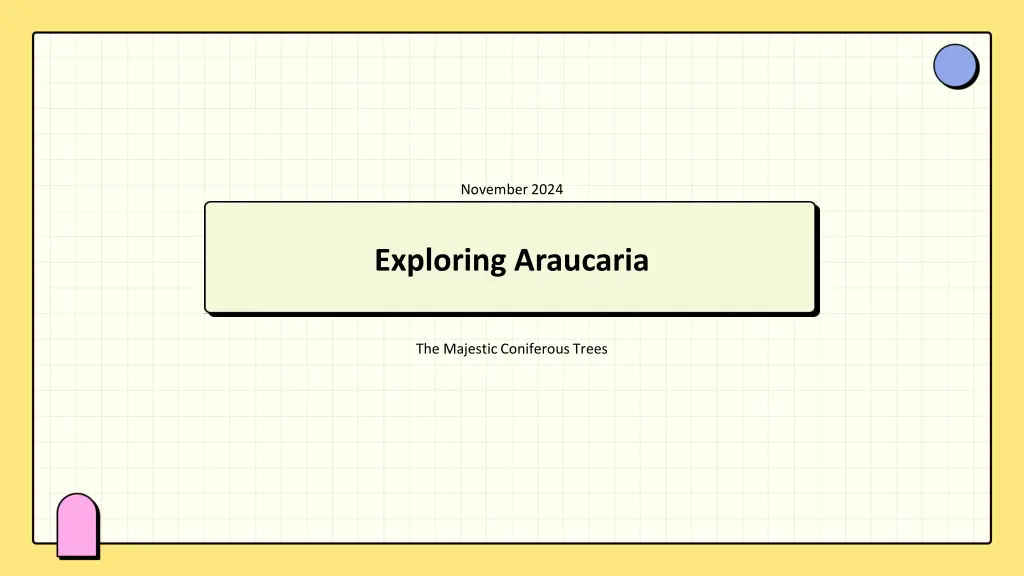
Explore the Enchanting World of Araucaria Trees
Discover the beauty and significance of Araucaria trees, their ecological importance, habitat, and more in this insightful exploration. Learn about their scientific classification, physical characteristics, and conservation efforts to protect these majestic coniferous wonders.
Uploaded on | 4 Views
Download Presentation

Please find below an Image/Link to download the presentation.
The content on the website is provided AS IS for your information and personal use only. It may not be sold, licensed, or shared on other websites without obtaining consent from the author. If you encounter any issues during the download, it is possible that the publisher has removed the file from their server.
You are allowed to download the files provided on this website for personal or commercial use, subject to the condition that they are used lawfully. All files are the property of their respective owners.
The content on the website is provided AS IS for your information and personal use only. It may not be sold, licensed, or shared on other websites without obtaining consent from the author.
E N D
Presentation Transcript
November 2024 Exploring Araucaria The Majestic Coniferous Trees
Table of Contents 5 Ecological Importance 1 Introduction to Araucaria 6 Cultural Significance 2 Scientific Classification Physical Characteristics 7 Threats and Conservation 3 Habitat and Distribution 8 Uses of Araucaria 4
9 Research and Studies 10 Future of Araucaria 11 Conclusion
Introduction to Araucaria 1. Araucaria, the majestic genus, includes evergreen coniferous trees known for their unique structures and resilience. 2. These trees are primarily found in the Southern Hemisphere, showcasing their adaptability to diverse environments. 3. Their striking appearance makes them popular both in nature and as ornamental plants in gardens. Photo by Pexels 4. Understanding Araucaria enriches our appreciation for biodiversity and the beauty of Earth's flora.
Scientific Classification 1. A detailed look at the scientific classification of Araucaria Araucaria reveals its position in the plant kingdom. kingdom. 2. It belongs to the family Araucariaceae and class Pinopsida, emphasizing its coniferous characteristics. 3. The order Araucariales and division Pinophyta further define its unique ecological niche. Photo by Pexels 4. Classifying plants helps us understand their relationships within the ecosystem.
Physical Characteristics 1. Araucaria trees are characterized by their spirally arranged leaves and robust, tall trunks. 2. They can grow to impressive heights, often exceeding 60 meters, showcasing nature's grandeur. 3. Their wood is dense and durable, valued for various applications in construction and carpentry. 4. These trees stand as symbols of strength and resilience in Photo by Pexels the natural world.
Habitat and Distribution 1. Predominantly found in Australia, New Guinea, and South and South America, Araucaria trees thrive in diverse diverse habitats. 2. They adapt to various soil types, indicating their ecological versatility and survival skills. 3. Many species grow in mountainous regions, showcasing their resilience in challenging environments. Photo by Pexels 4. Understanding their habitat aids in conservation and protection efforts.
Ecological Importance 1. Araucaria trees play a crucial role in their ecosystems, ecosystems, providing habitats for various wildlife species. 2. Their seeds are a food source for birds and mammals, contributing to the food web. 3. By sequestering carbon, they help mitigate climate change, showcasing their environmental significance. Photo by Pexels 4. Conserving Araucaria enhances global biodiversity efforts.
Cultural Significance 1. In many cultures, Araucaria trees hold significant cultural cultural symbolism and are often featured in folklore. folklore. 2. They are cherished in landscaping, enhancing aesthetic beauty in public and private spaces. 3. Certain species are considered national symbols, reflecting cultural pride and heritage. Photo by Pexels 4. Recognizing their cultural importance fosters respect for nature.
Threats and Conservation 1. Araucaria trees face threats from deforestation, climate climate change, and invasive species. 2. Conservation efforts are essential to preserve their habitats and maintain biodiversity. 3. Engaging communities in conservation initiatives can help spread awareness and support. 4. Protecting Araucaria contributes to ecological balance Photo by Pexels and sustainability.
Uses of Araucaria 1. The wood of Araucaria is highly valued for furniture, furniture, construction, and crafts, showcasing its economic importance. 2. Many species have edible seeds, utilized in traditional dishes and local economies. 3. Their unique aesthetic appeal makes them popular for landscaping and garden design. Photo by Pexels 4. Sustainable use of Araucaria can benefit both nature and communities.
Research and Studies 1. Ongoing research on Araucaria focuses on their genetic genetic diversity and adaptability to climate changes. changes. 2. Studies aim to understand their role in ecosystems and potential medicinal properties. 3. Contributions from scientists help in conservation strategies and fostering resilience. Photo by Pexels 4. Research plays a crucial role in deepening our appreciation for these remarkable trees.
Future of Araucaria 1. The future of Araucaria depends on our collective responsibility to protect these trees and their habitats. habitats. 2. Promoting sustainable practices and raising awareness can help ensure their survival. 3. Encouraging engagement with local communities fosters appreciation and conservation efforts. Photo by Pexels 4. Together, we can secure a future for Araucaria and the ecosystems they inhabit.
Conclusion 1. Thank you for exploring the fascinating world of Araucaria Araucaria with us. 2. We hope this presentation inspired you to appreciate and protect these majestic trees. 3. Together, we can celebrate and safeguard biodiversity for generations to come. 4. Let s cherish and preserve our natural heritage! Photo by Pexels
